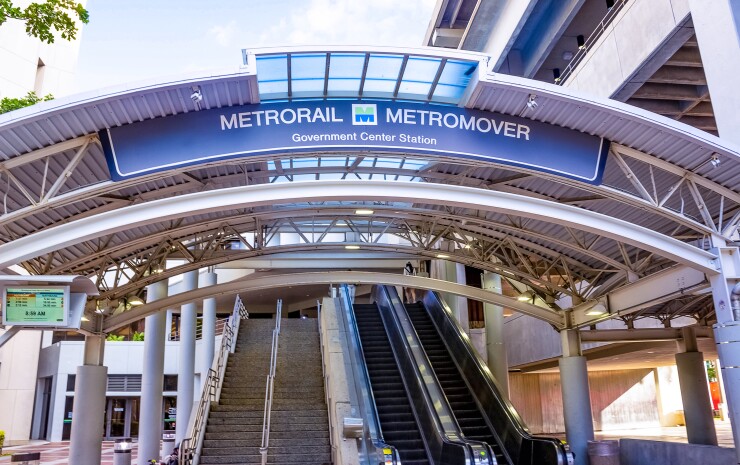Miami-Dade County is looking to a long-term public private partnership to transform a swath of underused county-owned downtown Miami into a high-density new neighborhood complete with a transit terminal, schools and parks.
The county floated a draft
The property is located in a Rapid Transit Zone to promote transit-oriented development that is fully controlled by the county.

It sits in the middle of a larger 28-acre site that serves as the local government seat with courts, offices and parking that's at the "center of the Miami urban landscape," according to the draft RFP and design guidelines.
The zoning allows for mixed-use properties with unlimited density and height to maximize the property to attract private investment alongside the public assets, according to the RFP.
Nine of the 11 parcels are marked for vertical development — towers can reach 80 stories — with the remaining two parcels for park space. The complex will feature a main library, schools, museum and a transit terminal that connects several systems.
Nearby amenities include a
The county will formally launch the RFP process in a few weeks and hopes to tap a final master developer by 2024. The development timeline is 10 to 15 years.
Models for MetroCenter include New York City's
"We are hoping this will be the benchmark for urban redevelopment worldwide," county Mayor Daniella Levine Cava told developers and attorneys at the presentation, according to local media reports. "It will be dynamic, safe, it will be prosperous, thriving and it will be economically and socially diverse."
Like Hudson Yards, MetroCenter is using so-called land value capture by leveraging public assets like transit and control over government land to raise private investment that can be used to address other government goals.
"The intensity, value and potential of the underlying assets allows the county to leverage the development site to address multiple challenges in our community, balancing highest and best use with social impact to bring both economic and societal reward to the community," the RFP said.
The P3 terms call for a 99-year lease. The developer will pay the county rent and the county will make payments to the developer for the infrastructure buildout.
From a credit perspective, the project has the potential to bring in new revenue and add to the local economy, but structuring the public-private partnership in a way that protects the AA-rated county from risks will be important, said Fitch Ratings analyst Michael Rinaldi.
"The key questions around most large public private infrastructure of mixed-use development centers are the extent, source and timing associated with the county's financial commitment to the project, and how it plans to protect itself against various project risks, including cost overruns," Rinaldi said.
The county enjoys a large, diverse tax base total and a population of around 2.7 million residents, or 12% of Florida's population, as of 2021, according to Fitch.

"It's a big announcement," Rinaldi said. "It creates incremental value, which for a place like Miami, which is fairly mature, has the potential to positively impact its revenues and economy."
Fitch and S&P Global Ratings both rate the county's general obligation bonds AA with a stable outlook. Moody's Investors Service pegs them at Aa2/stable.
Tentative financial terms call for the county to pay the developer for public improvements in the form of milestone payments, lease payments or other fixed fees. The county "intends to seek sources of funding for the public improvements," including possibly bonds, after a final agreement is signed, the RFP said.
The county will also reimburse the developer for the Downtown Intermodal Terminal — which will be built during the first phase — with funding that will include the county transit surtax, a tax of up to 1% that was approved by voters in 2002.
The developer will pay the county rent in exchange for the land. Developers are allowed to tap a mixture of private debt or equity, but can't use the county's credit or cross-collateralize with any other property or assets.
By requiring that the project include at least 2,000 units of affordable/workforce housing, or 35% of the total, the county hopes that the project will address
Miami's property values and housing costs are among the highest in the nation. In July 2022, Miami-Dade County home prices were up 13.5% compared to 2021, selling for a median price of $470,000, according to Redfin.
In her introduction to the county's fiscal 2023 budget, Levine Cava said investing in affordable housing is needed to sustain the region's economic growth. "We've become the least affordable community in the country, the epicenter of the national housing crisis," she said. "It's critical that we invest in solutions to tackle this crisis head-on."
Climate change is another well-known challenge and design guidelines require the developers to meet the county's host of resilience standards, including building to minimum sea-level rise projections of 21 inches in the next 50 years.
The county is meeting with developers this week to get comments on the draft RFP. Using that feedback, officials expect to release a final RFP by mid-September, according to Rita Silva, chief of P3 and innovative procurement for the county's Internal Services Department.
After competitive bidding, the county will shortlist up to five firms or consortiums who will then begin to negotiate with the county and help craft a second RFP proposal. The second document will be issued only to the short-listed bidders, who will submit technical and financial plans for the first phase of the development, including the downtown intermodal terminal. The county expects to tap a final master developer by 2024.
Jacobs Engineering Group, Inc. the county's technical advisor and AECOM Technical Services Inc. is the Department of Transportation and Public Works technical advisor. IMG Rebel Advisory, Inc. is the real estate and financial advisor.





